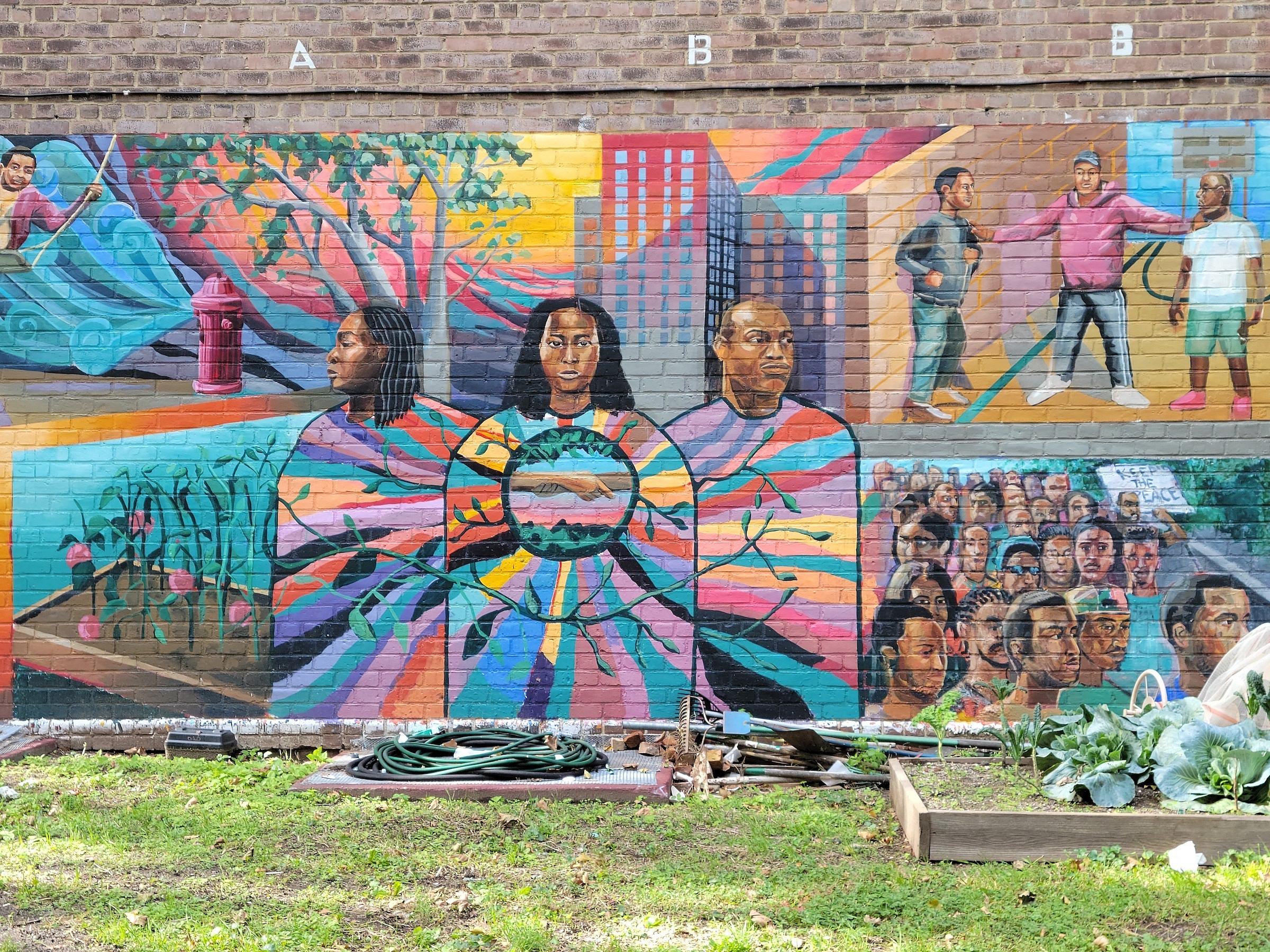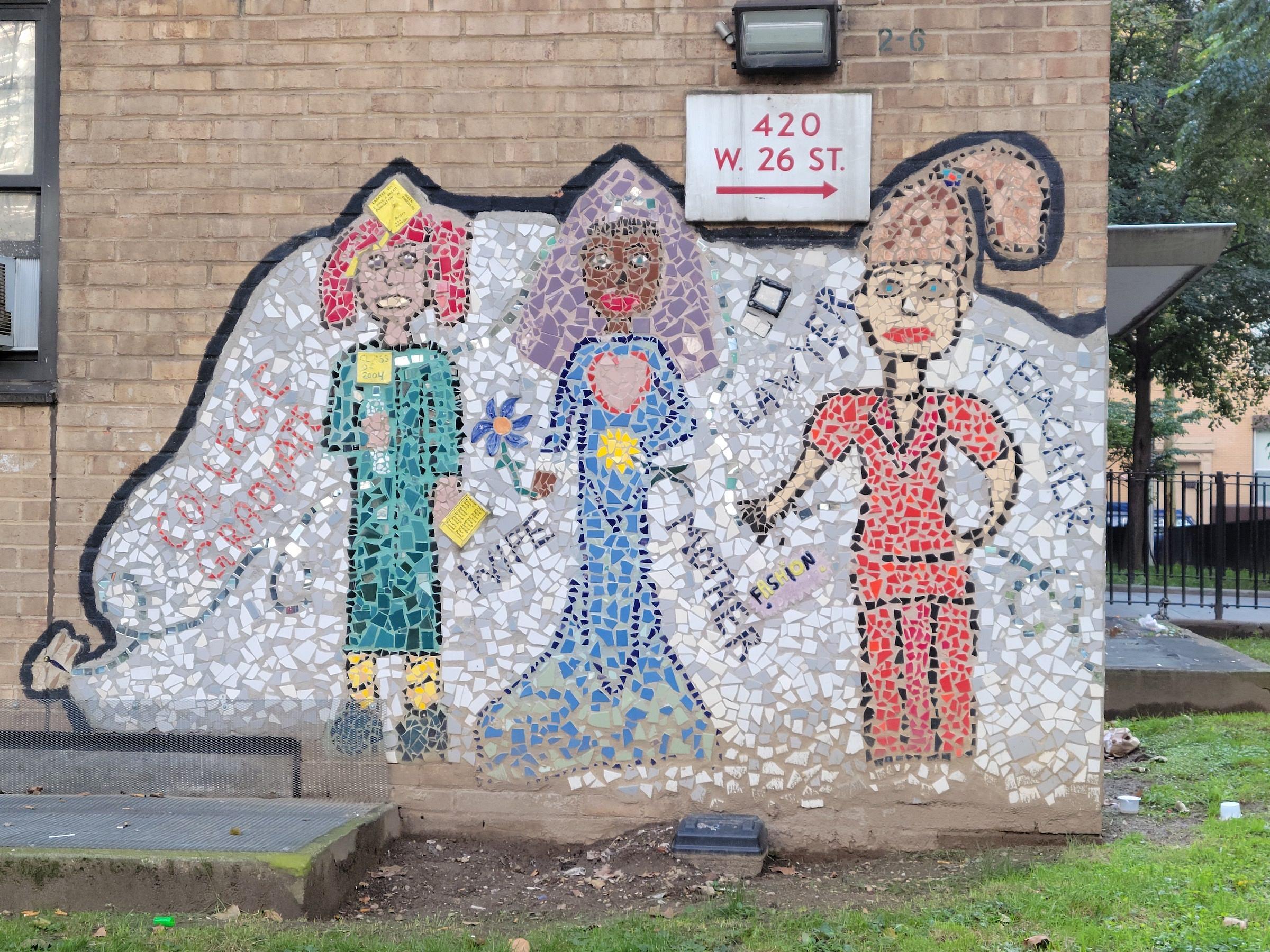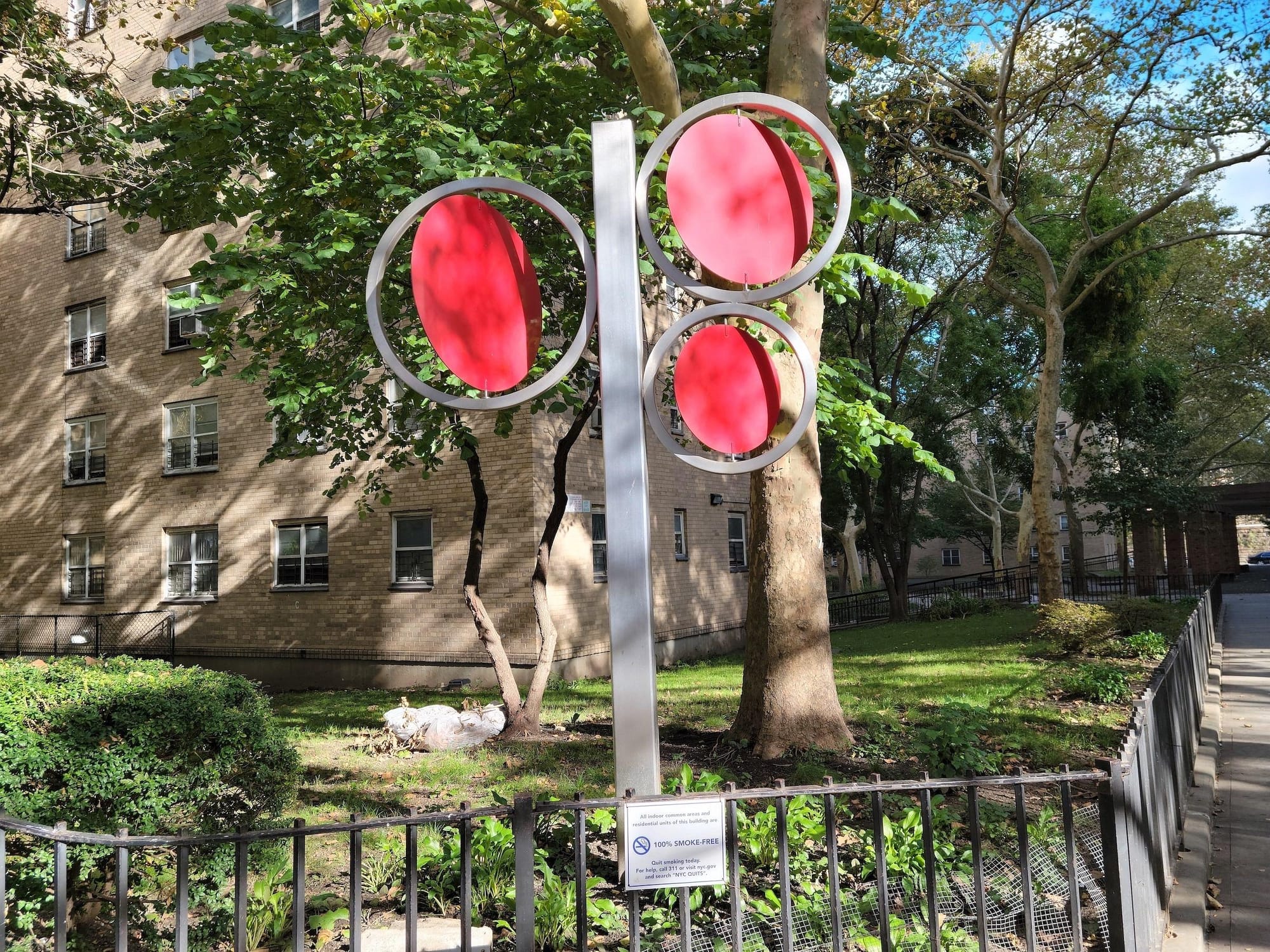Public art displays
Carver Houses, Madison Avenue and East 100th Street
Saint Nicholas Houses, 230 West 131st St.
Elliott Houses, 420 West 26th St.
On view year-round, until Elliott-Chelsea Houses demolition
“I like it,” said Charles Moton, referring to Roger Phillips’ metal sculpture titled Apple Tree, which stands near the garden at the New York City Housing Authority (NYCHA)‘s Carver Houses, the development where he has lived for more than 30 years. “It makes white people not afraid to come here.”
Phillips, who died in September 2022, installed the modern artwork in 2007 at Madison Avenue and East 100th Street in East Harlem. It demonstrates how public art at public housing seeks to connect people to other people and to an imagined future.
A visit to examine works on permanent display at three public-housing developments bears out this point, where location is an integral part of the art.
The higher than 12-foot-tall stainless steel apple tree has cheerful, bright red, painted, aluminum circles that swivel in the wind. The modern sculpture looks as if it could have easily come from MoMA’s Abby Aldrich Rockefeller Sculpture Garden. But it’s right at home at the NYCHA complex. The silver abstract tree trunk with silver hoops for branches and vines, shines in the sun, like playful signage to the Garden of Eden, where all of these apples remain on the tree.
Exclusive galleries and sculpture parks have exhibited Phillips’ signature pop art in places like San Francisco, London, Martha’s Vineyard, Scarsdale, N.Y., Greenwich, Conn., and the Monte Carlo Biennale in Monaco. His artwork graces the campuses of the University of Pennsylvania, Bard College, Emory University, and Sarah Lawrence College. Amongst thriving trees, against a backdrop of imposing brick towers readily associated with architecture of Section 8 and Section 9 housing, the clean geometric sculpture adds the appeal of a campus dormitory to the NYCHA lawn.
However, built in the mid to late-1950s, the Carver Houses has a history of turmoil. In 1970, the Young Lords, originally a Puerto Rican street gang in Chicago that evolved into a civil rights group, organized a rent strike with a 150-tenant sit-in at the manager’s office. The protesters demanded more Housing Authority police, according to the book Public Housing Myths: Perception, Reality and Social Policy, edited by Nicholas Dagen Bloom, Fritz Umbach, and Lawrence J. Vale. Fast forward to January 2023, John Dubois, a 25-year-old man was gunned down in a Carver Houses courtyard.
I asked Dr. Limor Kaufman, a licensed clinical psychologist, who teaches a course on the creative process at the School of Visual Arts in New York City, whether art could reduce people’s fear of crime and make areas more welcoming.
“I would say definitely. To create a sculpture can make a place more inviting,” said Kaufman. “People are always drawn to see art. So I think it can reduce negative aspects of an environment and invite people to come.”
“For years, when I lived out here, it was segregated,” explained Moton, who is African American. ”Everything past 96th Street was considered, basically the ‘hood. But it’s not the ‘hood. We know we’ve got our own who do bad things. But it’s not everybody.”
Moton emphasized that he has worked with people of all races, and the increased integration, which he has witnessed over the years, has led to positive changes and opportunities in his neighborhood.
“The apple tree is good because it helps bring people to our community,” he added.
The Carver resident was right about the sculpture bringing me to his neighborhood. From 96th Street walking south, I noticed he was also right, seeing a visible line of segregation he referenced. Moton recommended that I visit community murals to see art that fosters positivity in neighborhoods.

Massive murals span numerous exterior walls at the Saint Nicholas Houses, located at 230 West 131st Street in Central Harlem. The NYCHA website states: “This artwork acts as an illustration that peace is a more effective alternative to brute force.“
An ample palette of bright and pastel colors portrays people interacting in multiple vignettes. All of the people in the paintings are people of color living their daily lives. A younger and older woman smile as they together pour through a photo album. Children joyfully double dutch jump rope, with the jumper’s hair, cornrowed with beads, flying in motion. Two young people casually dressed in jeans sit on a stoop, and a young woman in a striped skirt walks down the sidewalk. Green trees and vegetation are painted within an urban landscape, resembling a neighborhood of public housing.
When U.S. Rep. Ritchie Torres was a New York City City Council member, he chaired the Public Housing Committee. Torres had grown up in public housing in the Bronx and secured the funding for this art project, as one of 15 NYCHA murals. In 2016, Brooklyn-based artist Jose de Jesus Rodriguez created the St. Nick’s mural, with young NYCHA residents, coordinated through the nonprofit Groundswell. The participants were paid and given the opportunity to explore their creative talents.
“It’s giving voice to the experience of their own lives and also creating an aesthetic experience in their environment,” said Kaufman, referring to this type of community mural.
NYCHA’s website describes the next section of the mural as stressing, “peace, unity, and progress.” A boy rides a swing, while a fire hydrant blows blue curls of water waves under a large yellow sun with pink, red, and orange rays. This wall continues with the more dramatic human interactions.
A garden continues to grow, next to three people looking in different directions with vague dissatisfaction on their facial expressions. In the center, hands symbolically clasp in solidarity. Panning to the scene further right, a peacemaker in red stands in the middle, separating two men, preventing a disagreement from escalating. One man wearing a black jacket holds his hands rounded in fists. The man in a white t‑shirt stares back at him. Underneath this trio, a crowd of brown and black people march at a protest. One person carries a sign. It reads, “Keep the peace.”
The mural conveys a sense of a proud tradition of Black, Latino, and folk art, and community. Yet last March, Georgia Alonza, a 24-year-old man, was fatally shot, while at this same housing site.
Can art reduce violence or undesirable behavior? Kaufman did not see a direct correlation of art to the prevention of crime. However, if people are experiencing a sense of alienation from their environment, connecting them, as part of a larger, more complex picture, supported by other programs, then the artwork could help reach the desired impact, the psychologist opined.

The Elliott Houses, completed in the 1940s, are part of NYCHA’s Elliott-Chelsea Houses. The works in this location explore whether art can encourage more constructive behavior. With white and grey tiles as a background canvas on the brown brick wall, a colorful mosaic hinges across two sides of a building. The tiles state: “I want to be a …” and figures of people with labels such as singer, veterinarian, basketball player, guard, baseball player, teacher, lawyer, mother, and college graduate line the wall. The basketball player wears a Michael Jordan Bulls number 23 jersey, dating the artwork back a few decades.
Nancy Rivera, a visitor at the development, sat on a bench at its playground. She said children worked on the mosaic. The brightly colored, cartoon-like characters look like grade school students’ crayon drawings memorialized into greater permanence.
Tile mosaics originated in Mesopotamia, dating back to the third millennium BCE. They often illustrated mythological scenes, enlivened by the timelessness of human imagination. The NYCHA mosaics depict would-be heroes in the world of children. The flat quality of people portrayed on the walls reminded me of childhood memories of playing “When I grow up” with my paper dolls that are now long gone.
In June, NYCHA announced a $1.5 billion plan to take a wrecking ball to the walls of all 2,055 units at Elliott-Chelsea Houses and the neighboring Fulton Houses. Essence Development and the Related Companies will build a new redevelopment, rehousing these units, adding 3,500 mixed-income apartments including market-rate apartments, 875 affordable housing units, and retail space. The location is in the highly desired Chelsea art gallery district and near Hudson Yards, where Related was one of the developers. The project is expected to take six years.
Until then, the child-like designs of the tile mosaic still appeal to people, like Rivera.
“It gives life to the building,” she said. “Pedestrians who are walking down the street take notice. They stop and can feel something. It was put there as an inspirational message to the children.”
The NYCHA art did make me stop. It illustrates what we define as basic rights of being human for all of us in a decent society: the right to food, a safe place to live, the right to imagine — and the right to dream. This art has meaning because it is with NYCHA. The sculpture, mural, and mosaic are about hope. For what is hope, but the possibility of a better tomorrow?






